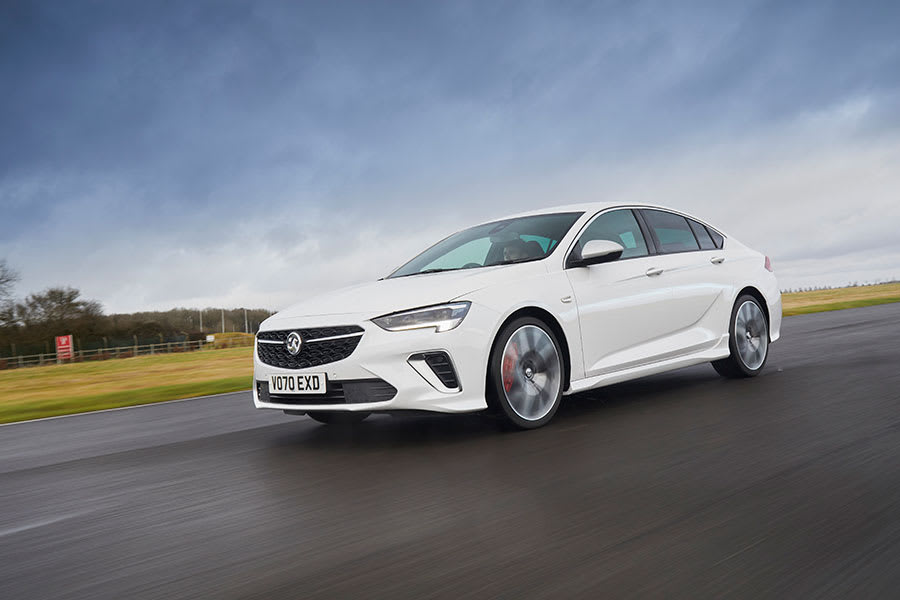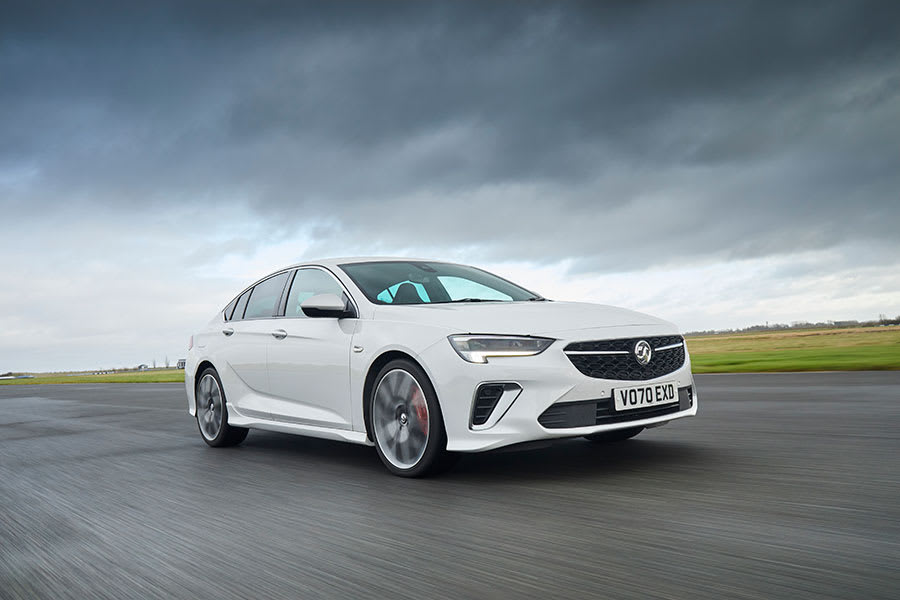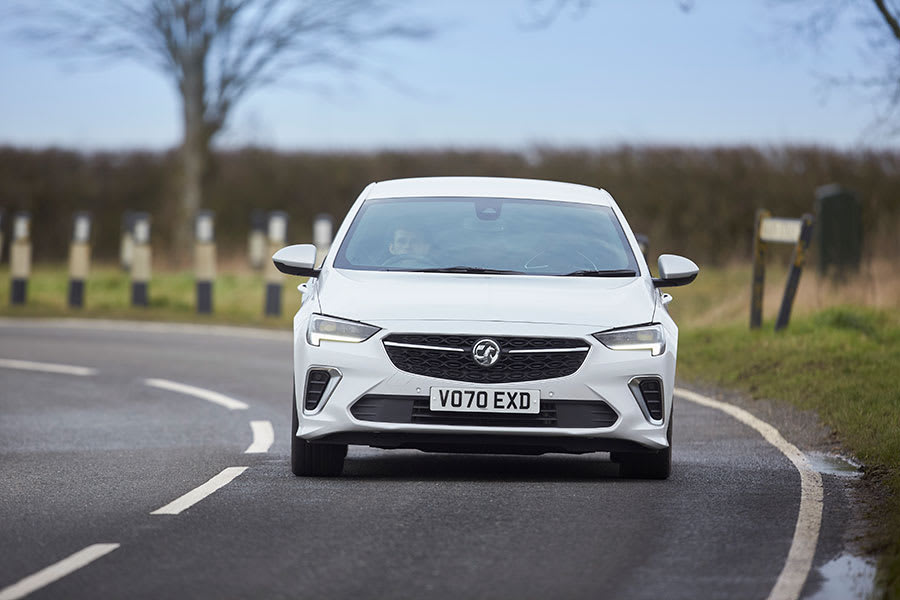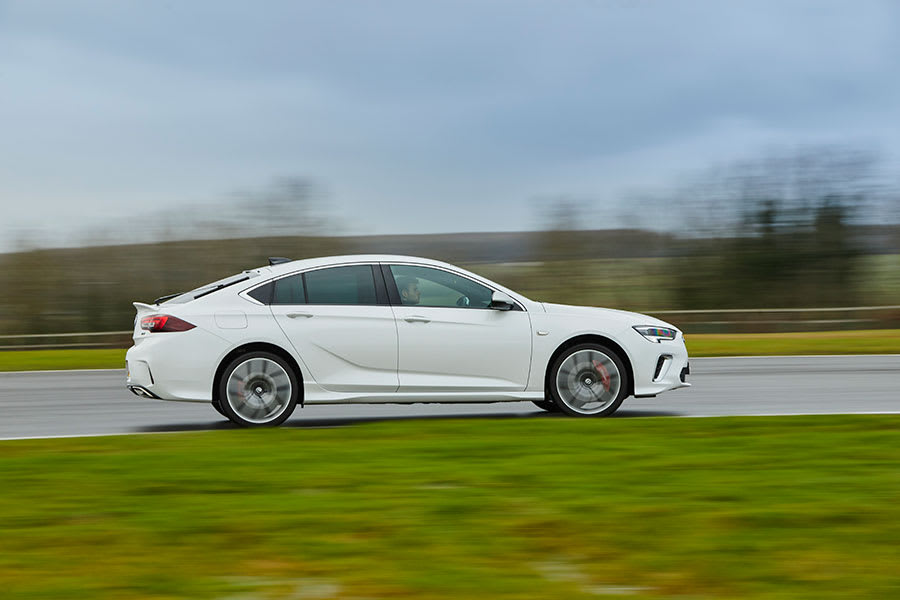.jpg)
Vauxhall Insignia GSi Review
.jpg)
Introduction
The VXR was the performance version of the old Insignia, but its discontinuation has left a void that, until now, has gone unfilled.
The Insignia Grand Sport GSi (to give it its full name) aims to bring much of what the VXR had – and add some extra spice on top. It isn’t being called a VXR, as Vauxhall’s performance brand is being rested ahead of an expected comeback as an all-electric range at a later date.
Review Sections
Select's rating score* - 3.6 / 5
At a Glance
The front of the Insignia has been given a freshen up, with thinner headlights and a more pointed look adding to the sportiness. Chrome-surround air intakes, along with a broader grille, give the impression that it’s wider and lower than its predecessor, too.
Indeed the GSi is lower, but only slightly. The revised suspension setup means the ride height is a centimetre less than other Insignias in the range. The 20-inch alloys complement the look nicely, while side skirts and more aggressive bumpers on the front and rear transform the Insignia from a sales rep motorway commuter to a mean machine - sort of.

We like the looks, but it is still very much an Insignia to the untrained eye, despite the integrated body kit. Although the new angled bodywork has been well-thought-out, it is still able to retain a sense of modesty in the process. Of course, whether that's a good or a bad thing is really in the eye of the beholder – but then the basic Insignia is hardly an ugly car.
At the back, there’s a spoiler, while towards the bottom, on either side of the number plate, the styling gives the car a chiselled-cheekbone sort of look.
Vauxhall’s also been keen to point out that the Insignia was extensively tested on the famous Nürburgring Nordschleife – the definitive proving ground for performance cars. The automaker claims it did a lap of The Green Hell 12 seconds faster than the old Insignia VXR. We’ll take that as an encouraging sign.
Key Features
The GSi’s engine harks back to Vauxhall's days under its old owners, General Motors, as GM developed it. It is a 2.0-litre four-cylinder turbo producing 230PS, connected to a nine-speed (yes, nine) automatic ‘box.
Elsewhere in the range, the same 2.0-litre power unit is available in detuned form, producing 200PS, while there is a diesel with 174PS. These lumps feature cylinder deactivation, which will switch off two of the car’s cylinders when the driver doesn’t require the extra power, saving on fuel. There are also two three-cylinder engines – a 1.4-litre petrol producing 145PS and a 1.5-litre diesel producing 122PS – but there is no hybrid option in the range. There is a six-speed manual gearbox available, as well as two automatics – an eight-speed and the nine-speed we just mentioned.
We are only interested in the GSi for now, though.

An active shutter by the front grille opens and closes, depending on the temperature, electrical and aerodynamic situation - further adding fuel savings. At the same time, it can stay shut to delay the vehicle's cooling after the engine is switched off, which also makes it warm up faster on start-up – particularly useful on a cold winter’s morning.
It also has a "mechatronic FlexRide" suspension – a flashy way of saying the suspension and shock absorbers can adapt to the road conditions in a fraction of a second.
There are four driving modes – Standard, Tour, Sport and Competition – the latter of which is only found on the GSi. These are linked to the FlexRide system, which also changes the ferocity of the accelerator pedal and the keenness of the upshifts. Each mode gives you an increasing amount of freedom to take the car to the extremes before electronics, such as the traction control, try to reign you in.
The IntelliLux headlights each feature a whopping 84 LEDs (the previous Insignia only had 16), which project more light onto the road to improve safety. They are automatically camera-controlled and move about to give a better view around corners. The lights take account of the weather, geography, road and driving conditions to maximise visibility in the dark, while also avoiding dazzling oncoming traffic.

Also included are electric and heated mirrors, front electric windows, heated leather seats with lumbar support, traction control, headlight washers, a wireless phone charger and a metallic body colour. At the same time, Brembo brakes are thrown in.
The infotainment system includes SatNav and features Apple CarPlay and Android Auto as standard on an eight-inch touchscreen.
Performance & Drive
The GSi is noticeably zippier than a regular Insignia, although it never really feels like it’s super quick.
It gets from zero to 62mph in 7.4 seconds, which, while not bad, is still a bit on the high side for what's being sold as a performance vehicle with a premium price tag to live up to. It tops out at 147mph, and again, this isn't bad, although we'd surely expect it to be able to reach the standard performance car threshold of 155mph like the old VXR could, even if it’ll never be driven at that speed anyway.

The GSi is the only one in the Insignia range to have four-wheel-drive, using Vauxhall’s Twinster torque vectoring system to prioritise power to each of the wheels independently. It works very well and certainly offers considerably more grip, both when moving off from a standing start and when driving around corners.
Its torque vectoring helps minimise understeer on entry, enabling you to point the car in the direction you want to go with ease and giving you the confidence to get the most out of the 230PS under the bonnet. Of course, you can turn the all-wheel-drive off, but cornering is so much better with it turned on.
As a result, the car seems very agile, complimenting the steering, which feels light and responsive. Turning up the driving modes makes the steering a tad heavier, but there isn’t much feel to give you any sense it's connected to anything. So, judging how much grip you have in damper weather conditions is not as intuitive as you might think.
The nine-speed automatic gearbox changes smoothly, but nine gears feels like the car has too much choice, and it can never really work out which one it should be in at any given time. In addition, though, you can use the steering wheel paddle-shifters to change gear. Mind you, they are rather sluggish when reacting to your inputs and sometimes ignore you altogether.
When braking, the GSi’s Brembo piston-controlled callipers feel more than sufficient, with incredible stopping power. They are activated by an electronic system as well, rather than using energy from the engine. This helps to save fuel.

The ride comfort is a strong point and, even with the 20-inch wheels, there’s a good balance between sporty handling and protecting your spine. Although, even when putting the car in Competition mode, there’s still a bit too much body roll in the corners.
Vauxhall has also done a lot of work on the Insignia's aerodynamics, and the lack of wind noise suggests it’s as good at smoothing out the airflow as it claims.
Overall, the GSi is nimble and good to drive, but it lacks the genuine excitement, refinement and grunt to bother the more sophisticated premium brands.
Changing the driving settings between Standard, Tour, Sport and Competition does make a difference, with each mode upwards offering more response from the accelerator and stiffening up the suspension. But, in truth, the changes are too subtle and not of sufficient significance to transform the driving experience.
Insignias are traditionally motorway cruisers built for sales reps travelling long miles from one end of the country to another. The GSi attempts to pull it more towards a performance car, but it feels a little bit of a halfway house.
Running Costs & Emissions
The GSi comes with a standard three-year or 60,000-mile warranty.
Vauxhall has done a lot of work to curb its emissions, and the GSi produces 181g/km of CO2 – the old Insignia VXR was 244g/km by comparison.
For the 230PS you get out of the 2.0-litre turbo engine, you only return 30.3mpg, and, in the real world, you can expect that figure to be lower.
30mpg in a car with this much power would have been acceptable a few years ago, but that's not the case these days. To put it in perspective, the fuel consumption figure for a 3.9-litre V8 in a Ferrari Portofino is 26.4mpg.
Interior & Technology
In all honesty, we are a tad disappointed by the interior.
With so much of the car’s improvements hidden away beneath the bodywork, we hoped Vauxhall would have put the same amount of vigour into redesigning the interior. But, in truth, there’s next to no difference, and anyone who glances inside an old Insignia and then this new one will be hard pushed to tell one from the other.
Don’t get us wrong – the old Insignia’s interior was good. It was well designed, and the build quality felt good. But somehow we just expected more of the new one, given all the effort to improve the car itself.

One plus point in keeping the same interior is that Vauxhall has resisted the urge to hide all its buttons in the infotainment unit. The system itself is fine but not spectacular and does seem a tad dated in design, while the touchscreen feels a bit on the small side nowadays.
The instrument display is part-digital, so there are still analogue dials, but it is well presented and gives you more than enough information. What's more, the heads-up display adds a nice premium touch.
The aluminium sports pedals look nice, while there are soft-touch materials across the dashboard. It feels well put together and sturdy without ever really giving you a sense of luxury.
There is plenty of space, too. The sports seats look the part and are very comfortable, while there’s decent headroom for taller drivers. Taller passengers may struggle, though, as the sloping roofline towards the rear limits headroom in the back. But there’s loads of space for your legs and feet, so you'll have no trouble fitting the kids in, who will be pleased they can keep their tablets charged on the journey thanks to the inclusion of two USB ports.

Practicality & Boot Space
The boot has a capacity of 490-litres. In addition, each of the three rear seats can fold down individually to increase the usable space to 1450-litres.
It is similar to the Ford Mondeo, which has 541-litres, increasing to 1437-litres, and the Volkswagen Arteon has 563-litres going up to 1557-litres.
The four-wheel-drive Skoda Superb, though, comfortably wins this one with 626-litres, expanding to 1760-litres.
In fairness, if you’re interested in a GSi, it is likely you may not give two hoots about the boot capacity, and, let's face it, 490-litres should be more than enough anyway.
There is a decent amount of storage inside the car, too, with well-sized door bins and two storage areas in the centre console, in addition to some space behind the gear lever.
Safety
The new GSi is part of the facelifted Insignia range, and the pre-facelift model was tested by Euro NCAP back in 2017, achieving a five-star rating.
It scored an impressive 93% for adult occupants, 85% for children, and 69% for safety assists, the latter of which doesn’t sound great, but safety technology has come a very long way in four years.

There is no reason to think the new one wouldn't beat this hands down, certainly on the safety assist score.
It features a new rear-view camera to improve rearward vision, and there's an optional rear cross-traffic alert that can detect objects approaching either side of the car as you reverse.
In addition, there’s a forward anti-collision system with automatic emergency braking, which also features pedestrian detection.
Other safety gizmos include lane keep assist, a side blind-spot alert, adaptive cruise control with emergency braking, traffic sign recognition and advanced park assist. There is also a head-up display on the windscreen so you can keep your eyes on the road.
Should a crash happen, an E-Call system will automatically send a distress call if the seatbelt tensioners or airbags are deployed in the car. At the same time, you can also activate the system manually at the push of a button.
Options
The options are … well … the options aren't.
Vauxhall has packed so much in as standard that there isn't really anything left for the automaker to throw at you.
There is a tow bar if you’re the sort of person who wants a performance car but also wants to tow a caravan for some reason. Oh – and there’s a rear window wiper. Wow, Vauxhall – behold the excitement!
We jest, of course. It is very unfair to blame Vauxhall for having a boring options list. The whole reason it's so dull, of course, is that the manufacturer has chucked in so much in as standard – and Vauxhall should be praised for doing so.

There is a catch, though, which we’ll come on to shortly.
Rival Cars
The Skoda Superb has a four-wheel-drive model, which offers plenty of kit and a more refined driving experience.
It is also more powerful, more economical and costs less. So, if you're excluding premium brands from your shortlist, the Superb very much lives up to its name.
The Volkswagen Passat and the Arteon are more polished contenders than the Vauxhall, too.
Other cars worth looking at are the Ford Mondeo and the handsome Kia Stinger.
Verdict & Next Steps
Overall, the GSi is a pleasingly good effort from Vauxhall. It won’t be troubling the premium brands anytime soon, but the Insignia is undoubtedly getting better and better.
It is good to drive and spacious, it has a pleasant if not particularly new interior, it is an improvement on the predecessor and includes a massive amount of kit.
We love car manufacturers who throw in loads of would-be optional extras as standard. But, as we said earlier, there's a catch.
Sadly, it feels as though Vauxhall has taken a car that should be a lot cheaper, made it compulsory for you to have loads of expensive options, and then demanded you pay for them all.
In truth, bog-standard Insignias aren’t bad cars nowadays and, because of that, we have to conclude that the GSi doesn’t offer a significant enough step up to justify the cost.
And, besides which, if you are looking in the price bracket of a GSi, it’s worth noting that you can get a BMW 330i M Sport for just a little more. Of course, you might not get the same level of kit as standard, but the reality is few will choose the GSi over the Bimmer unless there are significant savings to be had.
Where to next?
View latest Vauxhall Insignia GSi leasing deals - guide price from £522.58 per month inc VAT**
Looking for a great leasing deal? Check out our incredible range of car lease deals
Read our latest Reviews and find the right model for you
Want to know more about leasing? Take a look at our comprehensive Leasing Guides
Interested in everything motoring? Why not catch up on all the latest Car Leasing News.
*Score based on Select’s unique meta score analysis, taking into account the UK’s top five leading independent car website reviews of the Vauxhall Insignia GSi
**Correct as of 01/09/2021. Based on 9 months initial payment, 5,000 miles over a 48 month lease. Initial payment equivalent to 9 monthly payments or £4,703.21 Ts and Cs apply. Credit is subject to status.


















